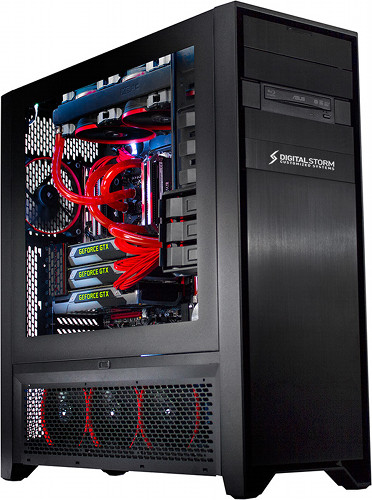
Enthusiast PC maker Digital Storm has announced the Hailstorm II, a new high-end gaming rig built off the gigantic, intimidating and awesome Corsair Obsidian Series 900D enclosure. This powerhouse provides incredible performance with up to four GPUs and two CPUs, making it one of a small handful of systems that offer both multiple processors and multiple graphics cards.
Packing this much hardware into any case, even one as large as the Obsidian 900D, can result in massive heat. To combat this, Digital Storm offers a liquid cooling system that can utilize up to four radiators ranging in size from 140mm to 480mm. These radiators are cooled by an array of large Corsair fans that draw in air from the bottom of the case and exhaust hot air out the top.
The system’s size provides plenty of room for expansion. There’s nine mechanical hard drive or SSD bays, three of which support hot-swapping, and four 5.25-inch optical bays. A front panel offers 2x USB 3.0 ports and 4x USB 2.0 ports, which are in addition to the ports offered by the motherboard (which varies based on configuration). Buyers can even configure the Hailstorm II with two power supplies for the most extreme multi-GPU configurations.
Digital Storm serves up the system in four “levels” which provide different hardware extremes. Level 1 packs a Core i7-3770K and Nvidia GeForce GTX 680 for $2,762 while the most powerful version, Level 4, includes an Intel Core i7-3970X with three Nvidia Titans for $8,085. Additional options can bring the total to over $10,000. All models come with a three-year warranty.
Gamers interested in the Hailstorm II can configure a system immediately.
Editors' Recommendations
- Some Intel CPUs lost 9% of their performance almost overnight
- Intel’s new CPU feature boosted my performance by 26% — but it still needs work
- Meet Blackwell, Nvidia’s next-generation GPU architecture
- Nvidia’s next GPU might follow Apple’s lead — and not in a good way
- Pimax’s 12K QLED VR headset wants to take virtual reality to the next level


